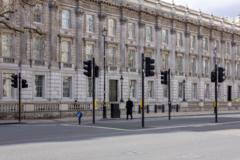What Goes On Inside the Government's Crisis Room?

Inside the COBR Meetings: A Look at Crisis Management in the UK
For years, the enigmatic COBR meetings have been a focal point for crisis management in the UK, hidden behind thick doors and strict protocols. The Cabinet Office Briefing Rooms (COBR) serve as the nerve center for government officials and senior ministers as they respond to national emergencies. Recently, the BBC's Newscast podcast gained unprecedented access to this critical space, providing a rare glimpse into the inner workings of crisis response in the UK. This article delves into the insights gathered from this visit, the evolution of emergency preparedness, and the role of data in modern governance.
The Significance of COBR Meetings
COBR meetings are convened in response to significant crises, whether they are natural disasters, public health emergencies, or security threats. The term "COBR" stands for Cabinet Office Briefing Rooms, indicating the gravity of the discussions held within. These meetings are characterized by their urgency, as they bring together key decision-makers who must quickly assess situations and implement strategies to manage and mitigate crises.
A Firsthand Experience
Stepping into COBR for the first time, the BBC team anticipated a mix of excitement and disappointment. The expectation was that it might resemble any other government office. Instead, the atmosphere was charged with a sense of responsibility and urgency. The room, dominated by a long rectangular table, is designed for focus and serious deliberation. The presence of large screens displaying essential information and a digital clock showing times in major cities around the world added to the room's gravity.
The Layout and Design
The stark, windowless environment is intentionally built to minimize distractions. Upon entering, one immediately notices the large digital wall clock, a reminder of the global implications of the decisions made within these walls. Galleries of government art, while seemingly out of place, serve as a psychological tool for stressed officials, offering moments of calm amidst the chaos of crisis management.
The Evolution of Crisis Management
The COVID-19 pandemic was a watershed moment for the UK's approach to crisis management. It exposed significant flaws in the existing frameworks for preparedness and coordination. In response, the government has sought to overhaul its systems, learning from past mistakes and aiming to be better equipped for future emergencies.
Lessons from the Pandemic
One of the key lessons learned during the COVID-19 pandemic is the importance of adaptability in crisis response. As noted by senior minister Pat McFadden, there is a risk in preparing solely for past crises while neglecting the unique challenges posed by future events. This highlights the need for continuous evaluation of crisis management strategies and the importance of forward-thinking approaches.
National Situation Centre (SitCen)
Located a short walk away from the main COBR room, the National Situation Centre (SitCen) plays a crucial role in the UK’s crisis management efforts. Managed by civil servant Roger Hargreaves, SitCen is designed to gather, analyze, and disseminate data during emergencies. This facility has evolved into a hub of real-time information, critical for informed decision-making.
The Role of Data and Technology
Data is at the heart of modern emergency response. The SitCen utilizes an array of datasets to create comprehensive maps of vulnerability within society. This innovative approach allows decision-makers to identify which populations are most at risk during emergencies, ensuring that resources can be allocated effectively. For example, energy companies maintain registries of vulnerable customers, enabling prioritization during power outages.
Mapping Vulnerability
The creation of vulnerability maps represents a significant advancement in emergency planning. These maps allow officials to visualize areas and populations that may require immediate assistance during a crisis. The integration of data from various sectors ensures that all aspects of vulnerability are considered, from health needs to social dependency.
The Future of Crisis Management
As the landscape of global threats continues to evolve, so too must the strategies employed by governments to manage crises. The UK's commitment to learning from past experiences is evident in its ongoing initiatives to enhance preparedness and response capabilities.
Testing Communication Systems
In a bid to improve national emergency communication, the government has announced plans for a nationwide test of its emergency alert system. Scheduled for Sunday, September 7, at 15:00 BST, this test will send simultaneous alerts to the majority of the UK's 87 million mobile phones. McFadden likens this initiative to testing fire alarms, emphasizing the importance of being prepared for emergencies.
Collaboration and Coordination
Effective crisis management hinges on collaboration among various government departments and agencies. The lessons learned from COVID-19 have underscored the necessity for seamless communication and coordination. As crises become increasingly complex, a unified approach is essential for effective responses.
Conclusion
The recent access granted to the BBC's Newscast podcast into the COBR meetings reveals a commitment to transparency and accountability in government crisis management. As the UK continues to navigate the complexities of modern emergencies, the importance of learning from past crises cannot be overstated. By leveraging data, enhancing communication systems, and fostering collaboration, the government aims to build a more resilient framework for emergency response.
As we reflect on the insights gained from this unprecedented look inside COBR, one must ponder: Are we truly prepared for the next crisis that may arise? The evolution of crisis management is ongoing, and the lessons learned today will undoubtedly shape the responses of tomorrow.
FAQs
What is the COBR meeting and why is it important?
COBR meetings, short for Cabinet Office Briefing Rooms, are crucial gatherings of senior ministers and government officials to coordinate responses to national emergencies or crises. They are significant because they facilitate rapid decision-making and strategic planning during critical situations.
How did the COVID-19 pandemic impact UK crisis management?
The COVID-19 pandemic exposed flaws in the UK's crisis management systems, prompting a reevaluation and enhancement of preparedness strategies. It emphasized the need for adaptability and real-time data in managing public health emergencies.
What role does data play in modern crisis management?
Data is vital in modern crisis management as it helps officials understand vulnerabilities within society and allocate resources effectively. The National Situation Centre utilizes various datasets to create vulnerability maps, ensuring that the most at-risk populations receive timely assistance during emergencies.
As we continue to adapt to an ever-changing world, the insights from the COBR meetings remind us of the importance of preparedness and resilience. What do you think is the most crucial aspect of crisis management? #CrisisManagement #EmergencyPreparedness #UKGovernment
Published: 2025-07-08 14:22:06 | Category: sport



